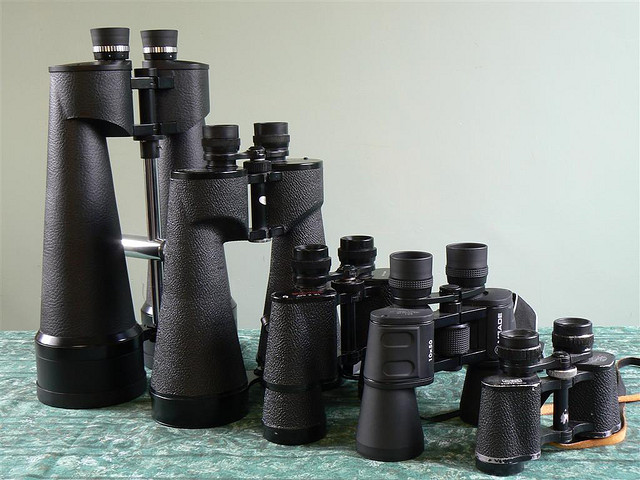
There are lightweight or heavy duty, simple or multi-feature, day-time or night-vision, expensive or cheap binoculars on the market. To determine the best pair for yourself, consider where they will be used most. Bird watching? Getting closer to the action in sports? Securing your campsite from predatory animals? Or observing your surroundings on a hunt?
What to look for:
Magnification power
- Each pair of binoculars is described by two numbers with an x in the middle. For example, 7×50, 10×25, 25×80 and so on. The first number is how many times the binoculars magnify the image you’re looking at, so 7×50 means the object appears 7 times larger.
- The second number is the size of the diameter of the lens in millimeters. That determines how much light the lens lets in. The smaller the number, the less light gets in, meaning they are better for viewing objects in daylight. For night-time viewing, you want at least a 60 mm lens but likely higher than that. So, a 10×25 pair would be ideal for bird-watching, while he 25×80 is a great lens for star-gazing.
- Note that for magnification levels higher than 8x, your hand cannot center the image steadily. For magnifications 8x and up, you may need a built-in image stabilizer feature or a tripod.
Condition & brand
- With binoculars, what you pay for is definitely what you get. Usually brand names with other reliable products on the market will be a good lens, although brand and price are not the only indicators of quality.
- Test the binoculars yourself to make sure the pair is in good condition. Move around all the parts on the binoculars to see how easily the parts move around and whether they stay in place when you’ve adjusted them. Jiggle a few loose parts without breaking the binoculars to see if everything is attached properly or if you’re at risk of losing a part as soon as you put it in your bag. Make sure the lens isn’t scratched. The scratches will be magnified through the viewfinder and may severely ruin the image you’re looking at.
Water resistance
- Water resistant is different from waterproof. Waterproof means the item doesn’t let water in at all. Water resistant means each crevice is tightly sealed and less likely to be damaged by water. If you will be boating, be sure to get waterproof binoculars. Water resistant binoculars are ideal for people who will be in conditions where the temperature changes drastically throughout the day, such as hot, humid days with cool nights, to avoid letting condensation ruin your lenses.
Weight
- The better the viewing capacity, the larger and heavier the binoculars. Hold the binoculars to your eyes or above your head for a few minutes. Do your arms get sore quickly? If you will be pulling these out/putting them back often (as on a hiking trip), this is probably not the best pair for you.
Color & sharpness
- Test the binoculars out quickly. View two highly contrasting objects a good few yards away from you in the store or wherever you are purchasing them. If the color on the edge of the closer object is distorted this will be a serious problem for those wanting to watch birds or other objects in the sky. This problem is called chromatic aberration.

Chromatic aberration is a visual distortion of the colors usually on the edges of objects. Notice the flower petals appear prismatic and fuzzy.
Once you buy the binoculars, immediately take them outside and try to view an environment similar to the one you’ll be using the lenses in most often. If you can clearly see what it is you’re trying to see from a great distance then this pair is likely good. Otherwise, return it to the store immediately and ask a sales clerk to advise your purchase.
Sometimes the deciding factor of your newest purchase is your budget alone. In that instance, either hold off on buying a pair since binoculars should be an investment that you can pass on to the next generation. Otherwise, I encourage you to go try out a few pairs in a store without purchasing the item new, instead find it for resale online or at a garage sale.
Enjoy your new pair of extended eyes! For further reading, see my binocular buying guide for popular outdoors situations.
Photo: (binoculars) John, (chromatic aberration) Reinhold Stansich
Photo: (binoculars) John Walker, (chromatic abberation) Ivan T

 Your Privacy Choices
Your Privacy Choices
 The
The